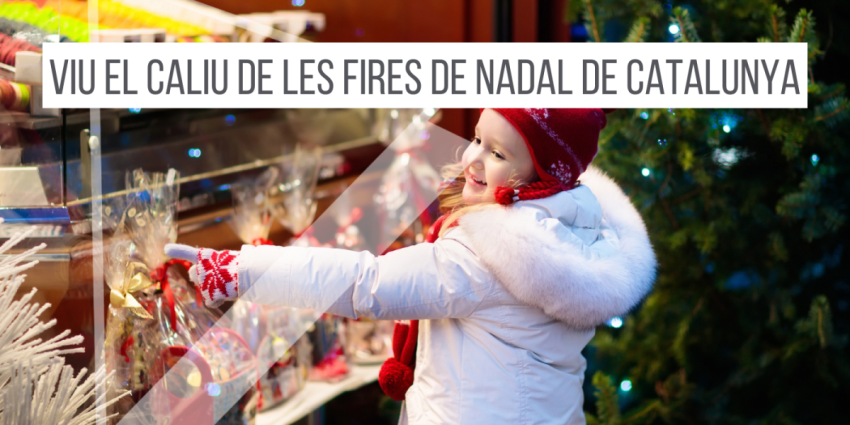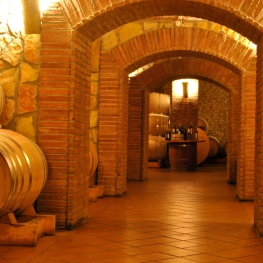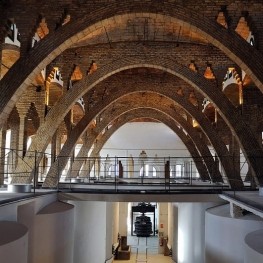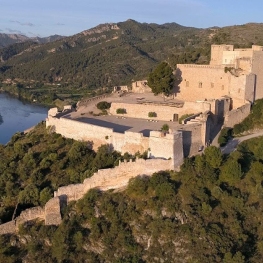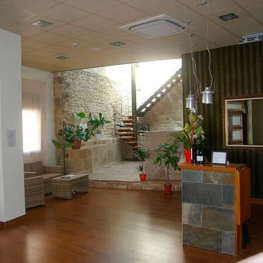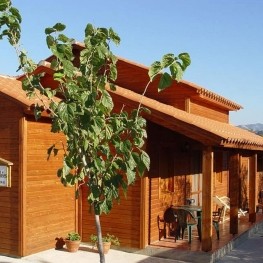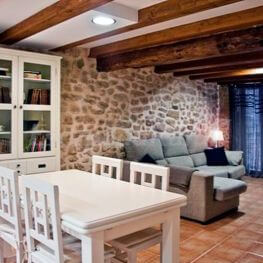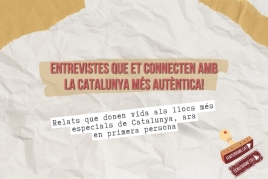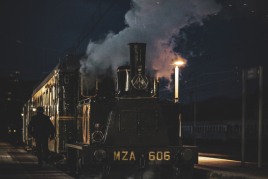Getting into the Terra Alta

The region of Terra Alta is the least industrialized area around the Ebro. It preserves a wide variety of unspoiled landscapes and towns that maintain the charm of the past. The most recent, the Battle of the Ebro, decisive chapter of the Spanish Civil War whose scars can be observed in these populations.
This area is famous for its precious oil and wine production, with denomination of origin itself, so we can not fail to visit without taking a wine in some of its stunning Art Nouveau wineries.
A portion of this route, I also Delve inside on the river Ebro i discover more delights offered this territory.
The Battle of the Ebro (1938)
 It is impossible to visit these lands without remembering the Spanish Civil War, unfortunately for them there was the bloodiest battle of the conflict and decided that its end.
It is impossible to visit these lands without remembering the Spanish Civil War, unfortunately for them there was the bloodiest battle of the conflict and decided that its end.
The Battle of the Ebro was a war of attrition between the Republican side and the fascist that lasted three months and claimed over 100,000 casualties. In order to prevent the rebels reach Valencia, Republicans crossed the Ebro river. After months of struggle, finally the Franco army and forced them to retreat back across the Ebro. Interestingly, he never knew why the Republican aviation not protected the brave advance, allowing the coup bomb discretion Republican positions and villages in this area.
You'll find more information on this topic in the Path of Peace: The Battle of the Ebro .
El Pinell de Brai
From Miravet take the T-324 road, after becoming the N-230, arrives at El Pinell de Brai . From Barcelona , take the AP-7 and take the N-420 until you reach the road above.
 You can not visit this town without approaching the Celler del Pinell, an agricultural cooperative winery built in 1922 and popularly known as the Cathedral of Wine. Art Nouveau is considered the masterpiece of Cesar Martinell i Brunet, a disciple of Gaudí. In fact, its architecture is so spectacular that is on the list of Historic Heritage.
You can not visit this town without approaching the Celler del Pinell, an agricultural cooperative winery built in 1922 and popularly known as the Cathedral of Wine. Art Nouveau is considered the masterpiece of Cesar Martinell i Brunet, a disciple of Gaudí. In fact, its architecture is so spectacular that is on the list of Historic Heritage.
If you want to delve into the world of wine then you visit Route Wine landscapes: DO Terra Alta .
Worth a walk in Pinell de Brai and observe the parish church of San Lorenzo, 1770, the gates of Llop, Pantoca and Vallés, the houses perched on a cliff 100 meters high and the remains of the wall castle, erected in the twelfth century. Four miles away is the house of Broi, considered the oldest in the village, where he remains his vantage point, construction of Templar.
It is impossible to walk through the land between ridges without going back to the past, as El Pinell de Brai was one of the populations most affected by the Civil War. The topography of the place gives it a strategic importance such that here the battle that would decide the end of it was fought the Battle of the Ebro. Therefore one of the must-sees in this town is Voices from the Front, Center Interpretation, an audiovisual exhibition displaying posters and other documents as part of both Republican fascist.
Blood in the Sierra de Pàndols
 At 10 kilometers, followed by the C-43 towards Gandesa , there is a turnoff to the Sierra de Pàndols. Passing the chapel of Santa Magdalena, reached the top, known as the dimension 705 or Punta Alta.
At 10 kilometers, followed by the C-43 towards Gandesa , there is a turnoff to the Sierra de Pàndols. Passing the chapel of Santa Magdalena, reached the top, known as the dimension 705 or Punta Alta.
There is the Peace Memorial, also called the monolith to the Fifth Bottle because most of the victims were under 18. At the end of a pass, a bucket of cement with a dove embossed legend says: "To all those who fought in the Battle of the Ebro". This sad event shares the spotlight with stunning views of the mountains.
Gandesa
The capital of the region also enjoys a work of César Martinell, Celler Agricultural Cooperative, where wine and oil are produced. Another example of industrial architecture decorated with turrets, windows, interior vaults and heavy ornaments on tiles. As in El Pinell de Brai , this city also has a Center for the Study of the Battle of the Ebro, with numerous war material on the conflict.
In the town center is the church of the Assumption, a mixture of Romanesque, Moorish, Gothic and Baroque, a former jail Gothic Palace and Castilian, the thirteenth century.
 But the journey does not end here. Thirteen kilometers is Fontcalda, a natural area with thermal water at 38 degrees that give reason for the spa of the same name, whose origins date back to the Middle Ages. According to legend, a shepherd found a picture with the figure of the Virgin near the fountain and took home their masters to show it. However, when it came, the image was gone. The pastor returned to the place where he had found and watched again. Neighbors Gandesa fascinated by history, but moved to the church the next day, they found that the image had returned to its original place. It was then erected a chapel, which later became a church. The present building is the third to have been and dates from the eighteenth century. Unfortunately, during the Civil War, the altar and the image of the Virgin was burned, so they are not original.
But the journey does not end here. Thirteen kilometers is Fontcalda, a natural area with thermal water at 38 degrees that give reason for the spa of the same name, whose origins date back to the Middle Ages. According to legend, a shepherd found a picture with the figure of the Virgin near the fountain and took home their masters to show it. However, when it came, the image was gone. The pastor returned to the place where he had found and watched again. Neighbors Gandesa fascinated by history, but moved to the church the next day, they found that the image had returned to its original place. It was then erected a chapel, which later became a church. The present building is the third to have been and dates from the eighteenth century. Unfortunately, during the Civil War, the altar and the image of the Virgin was burned, so they are not original.
Site of the Coll del Moro
Five kilometers from Gandesa , misuse TV-3531 road N-420, direction Calaceit find the site of the Coll del Moro, one of the few Iberian villages of Catalunya which we know, and you can visit their necropolis.
 Located in a strategic point, the Iberian settlement of Coll del Moro allowed the tribe ilercavones control the vast territory where natural pathways converged communication between Aragon and the mouth of the Ebro, and from which flows were controlled trade between the coast and the hinterlands.
Located in a strategic point, the Iberian settlement of Coll del Moro allowed the tribe ilercavones control the vast territory where natural pathways converged communication between Aragon and the mouth of the Ebro, and from which flows were controlled trade between the coast and the hinterlands.
It is one of the few sites that allow the joint visit of the town and the necropolis, as they barely know. It consists of a necropolis with three burial areas, dated between 800 and 500 BC, and a fortified the V century BC to AD This is dominated by a large tower in the highest settlement point, its elliptical shape not go unnoticed as they only found similar remains in some areas of the Mediterranean, as in Sicily (Italy).
Inside the town has discovered a workshop for processing flax and the manufacture of textiles.
Coll del Moro is part of the Route of the Iberians, Project Archaeology Museum of Catalonia wants to present the Iberian culture and peoples who lived more than 2,500 years ago.
Horta de Sant Joan
After the population Bot and following the county road C-111 arrived at the highest village of the Ebro, where the landscape is closely linked to Cubism. Because of the unevenness of the terrain, the houses of Horta de Sant Joan are stacked on each other, giving the village a cubist air that led Picasso to say "everything I know I learned in Horta," referring to the people his friend the painter Manuel Pallares. Not surprisingly, the village has been declared a National Cultural Interest. Therefore, this art lovers can not miss the Picasso Center, equipped with lithographs and places that inspired the painter.
 We started the route through the square, considered one of the most impressive of all Catalunya due to its characteristic porticos of the sixteenth century, decorated with arches. Once there, the visit requires knowing the Renaissance town hall, whose facade has a mural of Fernando VII in honor of the Cortes of Cadiz. Unfortunately, in poor condition. The plenary hall is dominated by a work of Matt Lamb, whose work also addresses the European Parliament in Strasbourg. In the basement we find the old prison, where we can still find some of the original pavement, dating from s. XVI. Currently accommodates exhibitions.
We started the route through the square, considered one of the most impressive of all Catalunya due to its characteristic porticos of the sixteenth century, decorated with arches. Once there, the visit requires knowing the Renaissance town hall, whose facade has a mural of Fernando VII in honor of the Cortes of Cadiz. Unfortunately, in poor condition. The plenary hall is dominated by a work of Matt Lamb, whose work also addresses the European Parliament in Strasbourg. In the basement we find the old prison, where we can still find some of the original pavement, dating from s. XVI. Currently accommodates exhibitions.
In the square we stumbled upon the church of San Juan Baptista, thirteenth century. Gothic was originally built with a single nave with pointed windows polygon. Its facade is notable for its simplicity, with a flat rectangle and supervised by a rosette door. In the sixties was restored, endowing it with polychrome crystals that give color.
Horta de Sant Joan is a place to take it easy, because their interest is focused not only in the town center but also in the surrounding area, without going any further is one of the inputs to the Natural Park of the Ports.
 If we go back to the road by which we came, 500 meters we find a path to the right that leads to a path that leads to Olivo Lo Parot. Fifteen feet tall, this tree was declared a monument in 1990. This variety, now unknown, was grown in the Tarragona area and the Bajo Aragón and this specimen in question is believed to have more than two thousand years, ie part of the Iberian and Roman times.
If we go back to the road by which we came, 500 meters we find a path to the right that leads to a path that leads to Olivo Lo Parot. Fifteen feet tall, this tree was declared a monument in 1990. This variety, now unknown, was grown in the Tarragona area and the Bajo Aragón and this specimen in question is believed to have more than two thousand years, ie part of the Iberian and Roman times.
At the foot of the mountains of Santa Barbara, 2 kilometers from the village, the monastery of Sant Salvador d'Horta stands, also declared a historic-artistic monument. Built by the Knights Templar, has several buildings built during the thirteenth and seventeenth centuries. Under the arches there are several sarcophagi and badges related to the guild of builders. One of the tombs are thought to belong to Bernat d'Alguaire, riding teacher who led Cathedral Tortosa .
Near the convent is the Torre de Galindo, a defensive medieval tower dating from the fourteenth and fifteenth century. What makes it unique feature is the roof construction, only restrained by huge walls which act as buttresses and, at the time, represented an architectural revolution.
If we decide to climb the mountain of Santa Barbara shocking four chapels will come our way: San Onofre, San Pau, San Antonio and Santa Barbara. Continuing down a path to the left to reach the Cave of San Salvador, guarded by a statue of the saint to which the locals come to pray.
Arnes
Continuing on the road we arrived at this border town with Teruel part of the Natural Park of the Ports.
 The municipality of Arnes , built in the XVI century, stands out as one of the most important buildings of the Catalan renaissance in which no missing gargoyles, semicircular arches and impressive windows. Also noteworthy is the church of Santa Magdalena, built on a 1693 Gothic church, castle ruins, also the same style, portals giving access to the old town and the five chapels located throughout the town.
The municipality of Arnes , built in the XVI century, stands out as one of the most important buildings of the Catalan renaissance in which no missing gargoyles, semicircular arches and impressive windows. Also noteworthy is the church of Santa Magdalena, built on a 1693 Gothic church, castle ruins, also the same style, portals giving access to the old town and the five chapels located throughout the town.
Around Arnes also deserve comment here, not only because they are embedded in a unique environment, such as the Natural Park, but by the many old buildings. The hermitages of Santa Madrona (S. XV-XVI) and I Calvari (XIX); Within the source, the New Fountain and Garbanzo source; the two monumental trees and Pi Ramut The Pimpoll, over twenty feet high; and Povet Snow, seventeenth and eighteenth century, which originally store food during winters.
What to do
Enoturisme Celler Piñol
Batea (a 11.6 Km)Celler Piñol is a family winery located in Batea, dedicated to producing…
Cooperativa de Gandesa
GandesaYou can visit the cooperative as designed by Cesar Martinell, with the…
Castell de Miravet
Miravet (a 6.9 Km)The Miravet Medieval Castle is a remarkable example of the architecture of…
Where to eat
Restaurant Hotel Nou Moderno
Vilalba dels Arcs (a 7.7 Km)Hotel restaurant to enjoy the tranquility of Terra Alta and try the…
Where to sleep
Apartaments Les Valletes
ArnesLes Valletes Apartments are located in Arnes, a charming municipality in the…
Restaurant Hotel Nou Moderno
Vilalba dels Arcs (a 7.7 Km)Hotel restaurant to enjoy the tranquility of Terra Alta and try the…
Ca la Leonor
Bot (a 7 Km)Rural house from 1880, renovated in 2012, preserving the original wooden beams…
Enoturisme Celler Piñol
Batea (a 11.6 Km)Celler Piñol is a family winery located in Batea, dedicated to producing…

